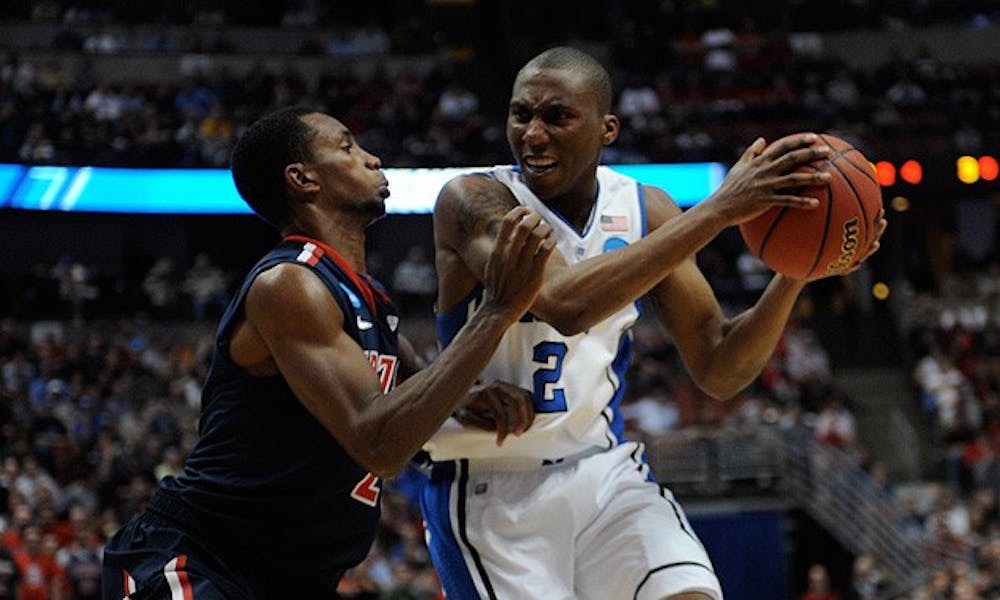Learning to play without Kyrie Irving was like beginning a whole new season.
The Blue Devils struggled to find an identity in the post-Irving era, shuffling through every conceivable starting lineup in the beginning of the ACC season. Initially, Nolan Smith shifted over to point guard while Andre Dawkins and Seth Curry battled for the last vacant perimeter starting spot. Freshman Tyler Thornton also briefly saw his minutes increase at the beginning of conference play, letting Smith return to his natural position on the wing on offense.
Meanwhile, Ryan Kelly, who had put on 25 pounds of muscle during the offseason, began to see his hard work pay off. After starting most of the team’s games in the fall, Kelly came off the bench for a three-game span in December before returning to the first five just one game before the Blue Devils’ ACC opener against Miami. The sophomore used his vastly-improved post game and perimeter shooting to keep the starting job for the rest of the regular season.
Throughout all of the lineup turmoil, though, Duke kept afloat on Smith’s back. The senior emerged as the most dangerous scoring threat in the conference behind what quickly became his hallmark: a crossover dribble and first step quick enough to leave even top defenders reeling. Smith quickly began posting the highest scoring totals of his career, even as he became the primary distributor on offense.
“I have to step up, run the show, lead these guys, even more than I’ve been trying to do,” Smith said after the Blue Devils crushed Bradley in Irving’s first game out. “I have to be more of a facilitator for these guys to get them involved and at the same time, stay effective.”
Smith averaged 23.3 points and 5.9 assists per game through the first month of ACC play as he began his quest to be the first player in history to lead the conference in both scoring and assists. Except for a minor road bump against Florida State in Tallahassee, the Blue Devils continued to find ways to win.
That is, until they went up to New York City to take on St. John’s in the building Smith playfully coined “Cameron North,” Madison Square Garden. The Red Storm blew out Duke 93-78 in a game that still was not as close as the score indicated. The contest exposed the Blue Devils’ most glaring weaknesses: a one-dimensional offense and absence of low-post play.
Smith had 32 points on 10-of-19 shooting, while none of his teammates scored over seven points except Kyle Singler. The reigning Final Four Most Outstanding Player scored 20 points on just 7-of-17 shooting, including an abysmal 1-of-7 from beyond the arc. The problem ran far deeper than simply one game, though, as the senior’s shooting funk from the perimeter lingered throughout the entire season. After posting a 39.9 shooting clip from 3-point range as a junior, his field goal percentage from deep dipped all the way down to 31.6 this season.
Making matters worse, he could no longer rely on Brian Zoubek—the nation’s most effective offensive rebounder a season ago, according to statistician Ken Pomeroy—to corral errant shots. The Blue Devils’ offensive rebounding percentage dropped from 40.3 last season to 34.8 this season, or from seventh to 82nd nationwide.
It took until February for another scoring threat to show up, but his emergence couldn’t have come at a more important time for Duke. Facing a 14-point halftime deficit to then-No. 20 North Carolina in Cameron Indoor Stadium, Seth Curry exploded, scoring 18 in the final period to bring his team back for a 79-73 win. Curry and Smith shot a combined 60 percent for the game—the pair made 14-of-19 from the floor in the second half alone—balanced out by Singler’s 3-of-17 shooting performance.
“At times during the season I could stand around and watch Nolan [Smith] and Kyle [Singler],” Curry said after the game. “But coming into tonight, I knew I had to be another punch out there for us.”
Curry stayed hot for the rest of the season, compiling a team-high 43.8 3-point shooting percentage. It seemed almost unfair, then, when Irving tantalized the media and crowd by warming up with the team at the ACC Tournament in Greensboro a month later. Soon after, it was announced he would play during the opening weekend of the NCAA Tournament, leading the West Region No. 1-seed Blue Devils against Hampton and Michigan.
After a tentative performance against the Pirates, Irving came to Duke’s rescue in a close game with the Wolverines, banking in the game-winning runner in a 73-71 victory.
The Blue Devils’ 93-77 shellacking at the hands of Arizona in the Sweet 16 was made all the more surprising because of Irving’s improvement. Duke appeared powerless against sophomore sensation Derrick Williams and allowed the fifth-seeded Wildcats to shoot almost 60 percent from the floor in the second half.
Almost as suddenly as it had begun, Irving’s comeback with the Blue Devils was over. The loss to Arizona also marked the end of Smith and Singler’s careers, the team’s two cornerstones and the only remaining starters from the 2009-10 NCAA Championship team. And with the Duke future of underclassmen Irving and Mason Plumlee uncertain, only one thing is for sure: The Blue Devils will have a completely different look come next season.
Get The Chronicle straight to your inbox
Signup for our weekly newsletter. Cancel at any time.

